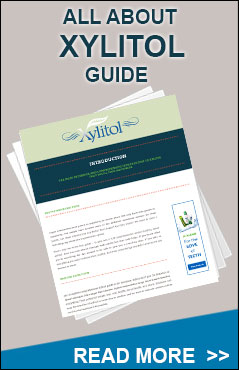Xylitol FAQs
- Is xylitol toxic to dogs?
- Is it dangerous to swallow gum with xylitol?
- What are the other health benefits of xylitol?
- When was xylitol discovered?
- What is Xylitol? How can I find products with xylitol?
- Is it possible to replace daily teeth cleaning with xylitol usage?
- How much xylitol should you use?
- How long does the protection last?
- Why does xylitol help protect teeth from cavities?
- Can diabetics use xylitol?
Is xylitol toxic to dogs?
Many dog owners are aware that chocolate, coffee, and grapes are toxic to dogs, but are unaware of the risk from ingesting the common natural sweetener, xylitol? Xylitol is a natural sweetener that is found in a variety of products, including chewing gum, toothpaste, mints, floss, candy, chewable vitamins, and sugar-free baked goods. While xylitol offers many health benefits to humans, it can be deadly to dogs and should not be fed to any pets.
Ingesting 100 milligram of xylitol per kilogram of bodyweight may cause a rapid release of the hormone insulin, causing a sudden decrease in blood glucose (potentially life-threatening hypoglycemia, low blood sugar) for dogs. The drop in blood sugar occurs within 15 minutes, while the symptoms of hypoglycemia (vomiting, depression, loss of coordination, seizures, or coma are all possible symptoms) may be seen within 30 minutes after the dog consumes the xylitol-containing product. Exposure to higher doses of xylitol may possibly result in fatal liver failure in some dogs.
Is it dangerous to swallow gum with xylitol?
No, it is not – but xylitol chewing gum, like other chewing gum, is not meant to be swallowed. If it does get swallowed, it will be transported naturally among other food through intestines. The best way to dispose of your chewing gum is to wrap in a piece of paper and throw it in a waste basket.
What are the other health benefits of xylitol?
First, you are doing your body a big favor by substituting more xylitol for sugar in your diet. While xylitol is just as sweet as table sugar (sucrose), it has about 40% fewer calories and 75% fewer carbohydrates. Xylitol also won’t raise your blood sugar like regular sugar does, putting tremendous strain on your system, causing negative health effects.
Xylitol has also been proven to inhibit the growth of bacteria. Research shows that this effect enables xylitol to help prevent bacteria and irritants from adhering to upper respiratory passages when used as a nasal wash. Studies have also shown that 8 grams of xylitol, taken orally every day, prevented about 40% of ear infections. For more information on these and other benefits, visit our Medical section.
When was xylitol discovered?
Xylitol was discovered almost simultaneously by German and French chemists in the late 19th century and has been used extensively in Europe since World War II. Its dental significance was researched in Finland in the early 1970′s, when scientists showed it had significant dental benefits. In Finland, Sweden, Japan and many other countries, xylitol is widely used in candy, gum and oral care products. While xylitol is fairly new in the U.S. market, its use is rapidly increasing as more people become aware of its unique health benefits.
What is Xylitol? How can I find products with xylitol?
Just visit our Products section! As an educational website, Xylitol.org provides information about a wide range of products that contain xylitol, Our rating system shows which products contain sufficient amounts of xylitol to be effective and all-natural ingredients.
Is it possible to replace daily teeth cleaning with xylitol usage?
A healthy mouth and teeth are a important part of vigorous everyday life. That is why it is important to take good care of them. To keep a beautiful and healthy smile brush you teeth daily and visit your dentists regularly.
How much xylitol should you use?
Xylitol is a natural and convenient way of supplementing daily dental care. Research shows that a mere 6g to 10g day is enough. Xylitol should be chewed immediately after a meal or a snack. If you eat more snacks, you of course need more frequent help from xylitol.
How long does the protection last?
Studies show the xylitol effect on teeth is long-lasting and possibly permanent. Low decay rates persist even years after the trials have been completed. In addition to starving harmful bacteria of their food source, use of xylitol raises the pH of saliva in the mouth. When pH is above 7, calcium and phosphate salts in saliva start to precipitate into those parts of enamel where they are lacking. For this reason, use of xylitol has demonstrated not only a dramatic reduction in new tooth decay, it also has shown the arrest and even some reversal of existing dental caries.
Why does xylitol help protect teeth from cavities?
Sugar feeds bacteria in your mouth, causing them to multiply rapidly. This metabolic process produces acids that cause cavities to begin to form. When you use xylitol gum or mints, the acid attack that would otherwise last for over half an hour is stopped. Because the bacteria in the mouth causing caries are unable to ferment xylitol in their metabolism, their growth is reduced. The number of acid-producing bacteria may fall as much as 90%. Since no acid is formed, the pH of saliva does not fall. – See more at: http://xylitol.wpengine.com/about-xylitol/faqs-questions-about-xylitol#sthash.JctYtfu5.dpuf
Can diabetics use xylitol?
The body does not require insulin to metabolize xylitol. For this reason polyols like xylitol produce a lower glycemic response than sucrose or glucose. This has made xylitol a widely used sweetener for the diabetic diet in some countries. If you do have diabetes, however, it’s important to consult your doctor or diet professional before incorporating xylitol into your daily diet.




